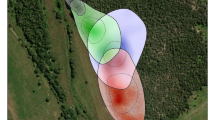Summary
-
1.
Descriptions of primate group structure emphasize both dispersive and cohesive activities as primary aspects of social organization. Among captive squirrel monkeys, laboratory studies of dominance relations are relatively abundant. However, a comprehensive behavioral analysis of Saimiri cohesive relations has not been completed. The present investigation provides such an analysis by focusing upon play, sexual, and affiliative activities in stable Saimiri groups.
-
2.
Social interactions were observed among two captive groups containing three males and five females. Daily observations during a four-week period were conducted to examine dyadic patterns of social interaction. Three intercorrelated clusters of cohesive behavior were identified. These clusters were used to provide converging indices of play, sexual, and affiliative bonds.
-
3.
Sociographic representation of social preference and social contacts indicated that social organization in both groups closely paralleled that reported for feral and semiferal Saimiri. Results are discussed in terms of their implications for assessing primate social bonds, as well as developmental changes in social cohesion as members of a social unit mature.
Similar content being viewed by others
References
Alvarez, F.: Effects of sex hormones on the social organization of the squirrel monkey, Saimiri sciureus. Unpublished doctoral dissertation, Tulane University (1968)
Anthoney, T.R.: The ontogeny of greeting, grooming and sexual motor patterns in captive baboons (Supersp. Papio cynocephalus). Behavior 31, 358–372 (1968)
Baldwin, J.D.: The social behavior of adult male squirrel monkeys in a seminatural environment. Folia Primatol. 9, 281–314 (1968)
Baldwin, J.D.: The ontogeny of social behavior of squirrel monkeys in a seminatural environment. Folia Primatol. 11, 35–79 (1969)
Baldwin, J.D.: The social organization of a semifree-ranging troop of squirrel monkeys (Saimiri sciureus). Folia Primatol. 14, 23–50 (1971)
Baldwin, J.D., Baldwin, J.I.: The ecology and behavior of squirrel monkeys (S. oerstedi) in a natural forest in western Panama. Folia Primatol. 18, 161–184 (1972)
Baldwin, J.D., Baldwin, J.I.: The role of play in social organization: Comparative observations on squirrel monkeys (Saimiri). Primates 14, 369–381 (1973)
Bernstein, I.S.: Primate status hierarchies. In: Primate behavior, Vol. 1. Rosenblum, L. (ed.). New York: Academic 1970
Chance, M.R.A.: The social bond in primates. Primates 4, 1–22 (1963)
Dolhinow, P., Bishop, N.: The development of motor skills and social relationships among primates through play. In: Primate patterns. Dolhinow, P. (ed.). New York: Holt, Rhinehart & Winston 1972
DuMond, F.V.: The squirrel monkey in a seminatural environment, In: The squirrel monkey. Rosenblum, L.A., Cooper, R.W. (eds.). New York: Academic Press 1968
DuMond, F.V., Hutchinson, T.C.: Squirrel monkey reproduction: The ‘fatted’ male phenomenon and seasonal spermatogenesis. Science 158, 1067–1070 (1967)
Fairbanks, L.: An analysis of subgroup structure and process in a captive squirrel monkey (Saimiri sciureus) colony. Folia Primatol. 21, 209–224 (1974)
Hopf, S.: Study of spontaneous behavior in squirrel monkey groups: Observation techniques, recording devices, numerical evaluation and reliability tests. Folia Primatol. 17, 303–388 (1972)
Hopf, S., Hartmann-Wiesner, E., Kühlmorgen, B., Mayer, S.: The behavioral repertoire of the squirrel monkey (Saimiri). Folia Primatol. 21, 225–249 (1974)
Jolly, A.: The evolution of primate behavior. New York: Macmillan 1972
Latta, J., Hopf, S., Ploog, D.: Observations on mating behavior and sexual play in the squirrel monkey (Saimiri sciureus). Primates 8, 229–246 (1967)
Mason, W.A.: Field and laboratory studies of social organization in Saimiri and Callicebus. In: Primate Behavior: Developments in field and laboratory research. Rosenblum, L.A. (ed.). New York: Academic Press 1971
Mason, W.A.: Differential grouping patterns in two species of South American monkey. In: Ethology and psychiatry. White, N. (ed.). Toronto: University of Toronto 1974
Ploog, D.W.: The behavior of squirrel monkeys as revealed by sociometry, bioacoustics and brain stimulation. In: Social communication among primates. Altmann, S.A. (ed.). Chicago: University of Chicago Press 1967
Ploog, D., Blitz, J., Ploog, F.: Studies on social and sexual behavior of the squirrel monkey (S. sciureus). Folia Primatol. 1, 29–66 (1963)
Ploog, D.W., Hopf, S., Winter, P.: Ontogenese des Verhaltens von Totenkopfaffen (Saimiri sciureus). Psych. Forsch. 31, 1–41 (1967)
Poirier, F., Smith, E.O.: Socializing function of primate play. Am. Zool. 14, 275–287 (1974)
Richards, S.: The concept of dominance and methods of assessment. Anim. Behav. 22, 914–930 (1974)
Rosenblum, L.A., Cooper, R.W.: The squirrel monkey. New York: Academic 1968
Rosenblum, L.A., Kaufman, I.C.: Variations in infant development and response to maternal loss in monkeys. Am. J. Orthopsychiatry 38, 418–426 (1968)
Smith, M., Harris, P.J., Strayer, F.F.: Laboratory methods for the assessment of social dominance among captive Saimiri sciureus. Primates 18, 977–984 (1977)
Strayer, F.F., Bovenkerk, A.: The relation of group status to measurement of preference among squirrel monkeys. Paper presented at meeting of the Western Psychological Association, Anaheim, California (1973)
Strayer, F.F., Bovenkerk, A., Koopman, R.F.: Social affiliation and dominance in captive squirrel monkeys (S. sciureus). J. Comp. Physiol. Psychol. 89, 308–318 (1975a)
Strayer, F.F., Taylor, M., Yanciw, P.: Group composition effects on the social behavior of captive squirrel monkeys (S. sciureus). Primates 16, 253–260 (1975b)
Thorington, R.W.: Observation of squirrel monkeys in a Colombian forest. In: The squirrel monkey. Rosenblum, L.A., Cooper, R.W. (eds.). New York: Academic 1968
Zuckerman, S.: The social life of monkeys and apes. London: Rutledge 1932
Author information
Authors and Affiliations
Rights and permissions
About this article
Cite this article
Strayer, F.F., Harris, P.J. Social cohesion among captive squirrel monkeys (Saimiri sciureus). Behav Ecol Sociobiol 5, 93–110 (1979). https://doi.org/10.1007/BF00302698
Received:
Issue Date:
DOI: https://doi.org/10.1007/BF00302698




